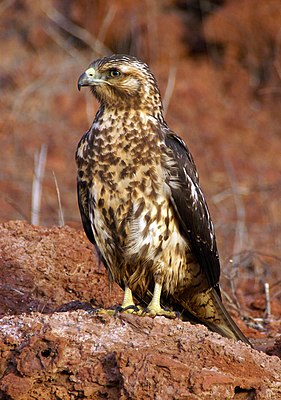Galapagos Buzzard
| Galapagos Buzzard | ||||||||||||
|---|---|---|---|---|---|---|---|---|---|---|---|---|

Galapagos buzzard ( Buteo galapagoensis ) |
||||||||||||
| Systematics | ||||||||||||
|
||||||||||||
| Scientific name | ||||||||||||
| Buteo galapagoensis | ||||||||||||
| ( Gould , 1837) |
The Galapagos Hawk ( Buteo galapagoensis ) is a bird of prey from the genus of Bussarde . It is endemic to the Galapagos Islands. Its existence is considered to be endangered.
Distribution area and habitat
As the name suggests, it is only native to the Galapagos Islands. Its habitats range from tropical forests to steppes and mountains.
properties
The Galapagos buzzard becomes up to 56 cm long and reaches a weight of 650–850 g. The plumage is the same in males and females. Its plumage is dark brown and the tail is striped with gray. The female is much larger than the male.
Reproduction
The buzzards nest in trees and often use the same nest several times. With each brood, the nest is enlarged so that it can become very large over the years. Both the male and the female practice brood care .
The female mates with an average of two (one to eight) male buzzards. There are completely monogamous populations, but also populations where all females have several males. The males are usually not closely related to each other and all take part in the care of the brood. Which of the male buzzards the young animal ultimately descends from seems to be a coincidence. If there are several young animals, they usually come from different fathers.
Both males and females incubate up to three eggs. After hatching, only the male hunts first while the female stays with the young and feeds them with the prey, later both parents feed and hunt. Most of the time, only one young fledged at two months. The boy stays with his parents for up to four months before they chase him away.
Hunting behavior
The Galapagos buzzard mainly hunts from the air. It eats small mammals, reptiles, insects and other arthropods as well as smaller birds, stranded dead fish and other carrion.
Trustfulness
Like island animals that are unaware of any natural predators, the Galapagos buzzard has lost its flight instinct . The fact that the Galapagos buzzards are not just tame is noticeable when they are threatened: Even if the mostly poor local buzzards who hunt their chicks are beaten to death with a stick, the animals do not become shy, like a normal wild animal, in our opinion, it should , but do not fly away even if they have already been hit by the stick. This clearly distinguishes them from our domestic dogs, for example, which can really go wild. Due to the lack of flight instinct, it is highly endangered on human-inhabited islands. (P. 425 ff., P. 46)
origin
Investigations of the mitochondrial DNA of the Galapagos buzzard and its closest relative, the prairie buzzard ( Buteo swainsoni ) show that the ancestors of the Galapagos buzzards colonized the islands around 300,000 years ago. This makes them the youngest immigrants to immigrate to the islands, compared to the Darwin's finches whose ancestors came to the islands about 2-3 million years ago. However, there is evidence that the Galapagos buzzards are already beginning to split into several species.
Web links
- Avibase data set Galapagos buzzard (Buteo galapagoensis) (Gould, 1837)
- Videos, photos and sound recordings of Buteo galapagoensis in the Internet Bird Collection
- Buteo galapagoensis inthe IUCN 2013 Red List of Threatened Species . Listed by: BirdLife International, 2012. Retrieved November 18, 2013.
swell
- ↑ a b c Irenäus Eibl-Eibesfeldt: Galápagos. Noah's Ark in the Pacific. Piper, Munich / Zurich 1991, ISBN 3492212328
- ↑ a b Das-Tierlexikon.de: The Galápagos buzzard
- ↑ J. Faaborg, PG Parker, L. DeLay, Tj. de Vries, JC Bednarz, S. Maria Paz, J. Naranjo and TA Waite; Confirmation of cooperative polyandry in the Galapagos hawk (Buteo galapagoensis); Behavioral Ecology and Sociobiology, Volume 36, Number 2 / February, 1995, pp. 83-90; Springer, Berlin / Heidelberg; 0340-5443 (print) 1432-0762 (online)
- ↑ Jennifer L. Bollmer, Tania Sanchez, Michelle Donaghy Cannon, Didier Sanchez, Brian Cannon, James C. Bednarz, Tjitte de Vries, M. Susana Struve, Patricia G. Parker: Variation in morphology and mating system among island populations of Galápagos Hawks In: The Condor 105, No. 3, 2003, pp. 428-438, doi : 10.1650 / 7101
- ↑ Michael H. Jackson: Galápagos. A natural history. Calgary: University of Calgary Press 1993. ISBN 1-895176-07-7
- ↑ Bollmer, Jennifer L .; Kimball, Rebecca T .; Whiteman, Noah Kerness; Sarasola, José Hernán & Parker, Patricia G. (2005): Phylogeography of the Galápagos hawk (Buteo galapagoensis): A recent arrival to the Galápagos Islands. Molecular Phylogenetics and Evolution 39 (1): pp. 237-247. doi : 10.1016 / j.ympev.2005.11.014 (HTML abstract)
- ↑ JL Bollmer, RT Kimball, NT Whiteman, JH Sarasola, PG Parker; Phylogeography of the Galapagos hawk (Buteo galapagoensis): a recent arrival to the Galapagos Islands; 2006 Apr; 39 (1): pp. 237-247. Epub 2006 Jan 11; Molecular phylogenetics and evolution; ISSN 1055-7903